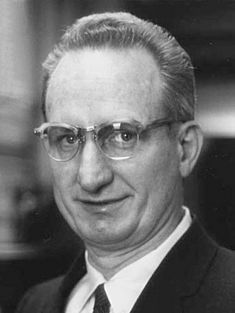James Rainwater facts for kids
Quick facts for kids
Leo James Rainwater
|
|
|---|---|

Leo James Rainwater
|
|
| Born | December 9, 1917 |
| Died | May 31, 1986 (aged 68) |
| Alma mater | Columbia University Caltech |
| Awards | Ernest Orlando Lawrence Award (1963) Nobel Prize in Physics (1975) |
| Scientific career | |
| Institutions | Columbia University Manhattan Project |
| Thesis | Neutron beam spectrometer studies of boron, cadmium, and the energy distribution from paraffin (1946) |
| Doctoral advisor | John R. Dunning |
Leo James Rainwater (December 9, 1917 – May 31, 1986) was an American physicist. He won the Nobel Prize in Physics in 1975. He received this award for his important work on the shapes of atomic nuclei.
During World War II, he helped develop the first atomic bomb as part of the Manhattan Project. In 1949, he came up with a new idea. He suggested that not all atomic nuclei are perfectly round, or spherical. This was different from what most scientists believed at the time. Later, other scientists, Aage Bohr and Ben Mottelson, proved his ideas were correct through their experiments. Rainwater also helped us understand X-rays better. He worked on projects for the United States Atomic Energy Commission and the Navy.
Rainwater started teaching physics at Columbia University in 1946. He became a full professor in 1952. In 1982, he was named Pupin Professor of Physics. He received the Ernest Orlando Lawrence Award in 1963. In 1975, he shared the Nobel Prize in Physics. The prize was given "for the discovery of the connection between collective motion and particle motion in atomic nuclei and the development of the theory of the structure of the atomic nucleus based on this connection."
Contents
Early Life and Education
Leo James Rainwater was born on December 9, 1917, in Council, Idaho. His father was a civil engineer who ran a local store. Sadly, his father died in the great influenza epidemic of 1918. After that, James and his mother moved to Hanford, California. His mother later remarried.
James was always called James or Jim, never Leo. In high school, he was very good at math, chemistry, and physics. He got into the California Institute of Technology (Caltech) because he did so well in a chemistry contest. He earned his Bachelor of Science degree in physics in 1939.
Working on the Manhattan Project
After Caltech, Rainwater decided to continue his studies at Columbia University. This was a bit unusual then, as Columbia wasn't famous for physics. But things were changing. Scientists like Enrico Fermi had joined the physics department. At Columbia, Rainwater learned from famous physicists like Isidor Isaac Rabi, Enrico Fermi, Edward Teller, and John R. Dunning.
He earned his Master of Arts degree in 1941. For his PhD, he built a special device called a neutron spectrometer. He used it to study how neutrons behave.
In 1942, Rainwater joined the Manhattan Project at Columbia. This was a secret effort during World War II to build atomic bombs. His team worked on a method called gaseous diffusion. This method was used to create a special type of uranium needed for the bombs. Rainwater studied how neutrons interact with different materials. After the war, his research was made public. He received his doctorate in 1946. In 1963, he was given the Ernest Orlando Lawrence Award for his work on the Manhattan Project.
Discovering Nuclear Shapes
After the war, Rainwater stayed at Columbia as a teacher. In 1948, he started teaching about the structure of atomic nuclei. Scientists had different ideas about how nuclei were built. One idea was the "liquid drop model," which imagined the nucleus like a tiny drop of liquid. Another was the "nuclear shell model," which described how particles orbit inside the nucleus.
In 1949, some experiments showed that atomic nuclei were not perfectly round. Rainwater realized this could explain why the two main models didn't always agree. He thought that if the atomic nucleus wasn't spherical, but had other shapes, it would make sense. He published his idea in 1950.
By chance, Aage Bohr was sharing an office with Rainwater that year. Bohr decided to test Rainwater's idea. Bohr and Ben Mottelson did experiments that proved Rainwater's theory was correct. They published their findings in 1952 and 1953. Rainwater was surprised that other scientists hadn't thought of his idea sooner. He felt his model was very obvious.
Rainwater also directed the Nevis Laboratories at Columbia. He worked with his student Val Fitch to study muonic atoms. These are special atoms where an electron is replaced by a heavier particle called a muon.
When he got the call in 1975 that he had won the Nobel Prize in Physics, he first thought it was for his work on muonic atoms. But a few hours later, he learned it was for his earlier work on the structure of atomic nuclei, shared with Bohr and Mottelson.
Rainwater was a member of many important scientific groups, like the American Physical Society and the National Academy of Sciences. He retired in February 1986 and passed away on May 31, 1986.
See also
 In Spanish: Leo James Rainwater para niños
In Spanish: Leo James Rainwater para niños

